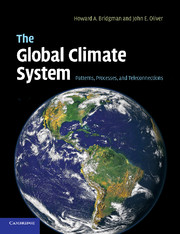Book contents
- Frontmatter
- Contents
- List of contributors
- Preface
- List of abbreviations
- 1 Introduction
- 2 Oscillations and teleconnections
- 3 Tropical climates
- 4 Middle-latitude climates
- 5 Climate of the polar realms
- 6 Post-glacial climatic change and variability
- 7 Urban impacts on climate
- 8 Human response to climate change
- 9 ESSAY: Model interpretation of climate signals: an application to Asian monsoon climate (Lau)
- 10 Conclusions and the future of climate research
- Other books on climatology and the climate system
- Index
- Plate section
- References
7 - Urban impacts on climate
Published online by Cambridge University Press: 05 June 2012
- Frontmatter
- Contents
- List of contributors
- Preface
- List of abbreviations
- 1 Introduction
- 2 Oscillations and teleconnections
- 3 Tropical climates
- 4 Middle-latitude climates
- 5 Climate of the polar realms
- 6 Post-glacial climatic change and variability
- 7 Urban impacts on climate
- 8 Human response to climate change
- 9 ESSAY: Model interpretation of climate signals: an application to Asian monsoon climate (Lau)
- 10 Conclusions and the future of climate research
- Other books on climatology and the climate system
- Index
- Plate section
- References
Summary
Introduction
Anthropological research tells us that humans originally congregated in central locations at important transport junctions, such as rivers, to trade goods, communicate, and to obtain information. Such locations eventually grew to villages, then to towns, and then to cities as human populations expanded, and the technology increased for buildings, roads, and so forth. Along with the expansion of population and the growth to cities came modifications to the environment, including changes to the local and regional climate. Depending on the state of development, cities are often noisy, smelly, polluted, densely packed, and overpopulated, with major difficulties associated with waste, water, the atmosphere, and human health. However, as Figure 7.1 shows, cities have many benefits to populations, including providing shelter, employment, services, technological development, education, cultural and social interactions, and income. Therefore cities have become essential to the lifestyle and well-being of human beings.
Spatially, cities cover less than 1.5% of the Earth's land surface. However, the latest summary of the state of cities around the world from the United Nations Environment Programme (GEO 2003) states that currently about 47% of the world's population live in cities. This is almost double the percentage in 1975 (27%). Projections during the first half of the twenty-first century suggest an average urban population growth of 2% per year, and that by 2050, 65% of the global population will live in cities.
Much attention has been paid to the development of megacities, those with populations of 10 million or more.
- Type
- Chapter
- Information
- The Global Climate SystemPatterns, Processes, and Teleconnections, pp. 205 - 243Publisher: Cambridge University PressPrint publication year: 2006



